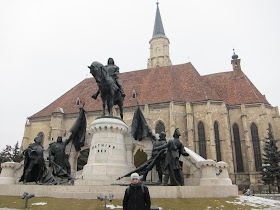We started our stay in Romania with the visit of two small towns in Transylvania, the central region of the country, that was once part of the Hungarian empire.
Cluj-Napoca, the capital of Transylvania, was our first stop, a university city with charming coloured buildings. Unfortunately, winter time is not the best period to visit this city. Snow is still present in February and a lot of touristic sights are closed or in renovation.
Piata Unirii
In Cluj, the two main squares, separated by 500 meters, host the two main religious buildings: a Romano-Catholic church and an Orthodox cathedral.
Matthias Corvine Statue in front of the Romano-Catholic church
Orthodox cathedral
In front of the Orthodox cathedral, the National Theater and Romanian Opera in a funny baroque-rococo style:
In case you ever wonder what the Ile-de-France region do with the old Roissy buses..
******
Then we went to Brasov, the most important city near THE renowned castle: DRACULA’S CASTLE!!;))
Mmh.. in fact, Bran’s castle only may have inspired the Irish author of Dracula. It seems that Bram Stoker have never actually been to Romania but collected many information about Romanian local folk and History. One historical character of relevance is probably a major source of inspiration for Dracula: the Prince of Wallachia, a bloody and punitive tyrant, most known as Vlad “Tepes” (Impaler). He inherited his other nickname, Vlad “Dracula” (meaning “the devil’s son in Slavonian), from his father. But this historical character only stayed a few days at Bran’s castle..
Vlad the Impaler
Anyway, this castle is impressive by its localization, built on a rock. Constructed in the 12th century, the castle have known a lot of successive renovations which have given him a unique cachet. The present interior has been designed for Queen Mary of Romania who lived there for much of the early 20th century. Today it still belongs to some of her grandchildren.
Bran's Castle
Interior courtyard
Street Apollonia Hirscher
Piata Sfatului
Trying the papanash (Roumanian pastry)!
******
Our last stop in Romania, the capital, Bucharest! According to everybody we met in Romania before going to Bucharest, this city would have disappointed us. It is true that with his wild traffic and countless stray dogs Bucharest is not the most welcoming city. However, Bucharest deserves to be discovered.
Piata Victoriei
People's House (Casa Poporului) is the fruit of Nicolae Ceauşescu’s megalomania. Also called “Palace of the Parliament”, this building is said to be the second biggest in the world after the Pentagon. 21 floors (14 floors above the street level and 7 under), 1.100 rooms, etc. Over one million people have participated to its construction started in 1983. And in fact the result is extremely impressive:




















Les Plaisirois pensent à vous !
ReplyDeleteQuelle excellente idée de nous permettre de suivre votre aventure et de profiter de vos très belles photos. Nous aussi on souhaite un maximum de photos de vous deux !
bisous
Serge et Danielle
Merci pour toutes ces photos et infos, qui nous font partager vos découvertes et votre émerveillement. On a fortement envie de vous rejoindre !!! Pour ma part, je rêve de visiter le château de Vlad l'empaleur !
ReplyDeleteBisous tout spécialement à ma cousine !
I just wanted to know if you know anything about these names for Romania historically: Morcala, Ghanala, Mernala, Renela, Laka, Bala, Ghena, Ghenala, Ginser, The Gitsers, Miss Lock, Senser Inter, Ola , Molak, Enela, Onala, Lava, Merlina, Sennela, Inkener, Morkala, Ursala, Sernala, Merka, Versse. They're from something called Romania Underground Lockers. I can't find any more information about it. If not thanks anyway.
ReplyDelete